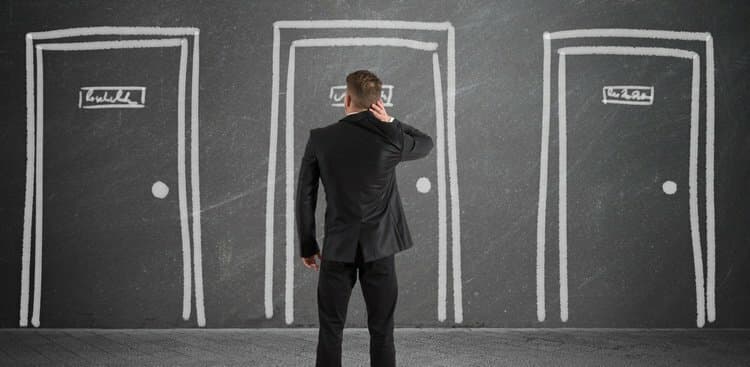This article is from our friends at LearnVest, a leading site for personal finance.
There’s an oft-quoted rule of thumb that says it takes 21 days to change a habit.
Meanwhile, it’s day 23, and you still can’t forgo your morning croissant in lieu of packing the cheaper (and healthier) granola bar from home. Seems easy enough to do—and yet, your autopilot has you entering the bakery every morning, like clockwork.
Does that make you feel down? Well, it shouldn’t. Habit change is dependent on a lot of factors, all of which may feel like they are conspiring against you. And besides, that 21-day rule seems largely to be the stuff of legend: One University College London study found that, on average, it took 66 days to form a new habit.
And who’s got that long? To save you time, we read five of the best behavior-change books out there to help you apply these expert ideas to your financial and professional life.
Consider it a sort of CliffsNotes to developing far better habits you won’t break.
1. Making Habits, Breaking Habits: Why We Do Things, Why We Don’t, and How to Make Any Change Stick
By Jeremy Dean
The Big Idea: Dean, a British psychologist and author of PsyBlog, describes the purpose that habits serve in our lives: In essence, they give your brain a rest from having to make difficult decisions by putting some things on autopilot. (Imagine how mentally drained you’d be if you had to rethink how to back out of your driveway every morning?)
But overcoming this “automaticity” (doing without thinking, in layman’s terms) is precisely why it takes so long to make or break a habit. Dean cites the aforementioned University College London research, which showed the range in time it can take to actually affect change: Drinking a glass of water with breakfast took about 20 days to become automatic, but something harder, like doing 50 sit-ups a day, took more than 84 days!
His Big Secret: Dean says one key to adopting a better habit is to create a connection between a specific situation and a resulting action, and then practice repeating that process. One way to do this is to put the desired outcome into an “if, then” statement. For instance, if you’re trying to be a kinder person this year, say, “If I see a person struggling with a stroller, then I will offer to help.” Dean calls this “implementation intention.”
How it Can Work for You: You can apply implementation intention to just about any habit you want to adopt. Just make sure the “if” trigger is not so specific that it gives you few opportunities to try out your new habit, says Dean, and not so wide that it’s too vague. For instance, if you want to chip away at credit card debt, try something like this: “If I am buying something that is less than $30, then I will use cash.”
2. Nudge: Improving Decisions About Health, Wealth, and Happiness
By Richard H. Thaler and Cass R. Sustein
The Big Idea: We know what decisions we should make in our lives—like reaching for the broccoli over the bacon, or buying the sedan over the sports car—but actually doing it is another matter. How can we make it easier on ourselves to make the right choice?
That’s the question authors Thaler and Sunstein seek to answer in their New York Times bestselling book. The two economists at the University of Chicago and Harvard provide examples from the world of public policy to show how small “nudges” in human behavior can help improve individual and societal behaviors.
Their Big Secret: They give the example of a manager in a school cafeteria who wants her students to eat healthier. She achieves this by simply moving the salad to eye level and puts the greasy pizza further back and out of reach. According to the authors, changing how the foods are displayed could up the consumption of healthier food by as much as 25%.
Best of all? It’s actually the easiest move. She hasn’t eliminated anyone’s freedom of choice; she’s simply made a small tweak that makes the healthier food decision a little more user-friendly. Thaler and Sunstein call this “choice architecture,” or influencing decisions by changing the context of how the choices are presented. They argue that, in a similar fashion, we can “nudge” other people, and ourselves, to make the best decision simply by making, or “architecting,” small tweaks to our own environments.
How it Can Work for You: In a nutshell, make it harder not to do the smart thing. Let’s take your 401(k) as an example. When you first enroll, you probably tell yourself that you’re going to increase your contributions by 1% gradually over time. That’s not bad advice, and we’re all for it.
But making a change to your contribution doesn’t happen with the snap of a finger. You have to tell human resources, remind yourself of when you’ll up the contribution—it can require a lot of legwork, so it becomes easy to stick with what you’ve got. (This is what experts call the “status quo bias.”)
So try the opposite. Start with a higher number first. If you were originally going to contribute 2%, but think you can make 5% work, start with your reach goal. It might feel like a bit of a stretch at first, but due to inertia, you’re unlikely to make the effort to decrease the contribution, opting to adjust your budget instead. You’ve made it harder to save less for retirement, and easier to save aggressively.
3. Gut Feelings: The Intelligence of the Unconscious
By Gerd Gigerenzer
The Big Idea: Let’s say you’re trying to choose between two job opportunities. You have a hunch that you’ll like working at Company A instead of Company B, but you’re not sure why. So you consult your friends, make a pros and cons list, and then end up choosing B based on the results. By the end of the first month, you realize you’ve made the wrong decision and say to yourself, “I totally overthought that. I should have just gone with my gut.”
Gigerenzer, managing director of the Max Planck Institute for Human Development in Berlin, would probably agree with you. The common belief is that the best conclusion is the most informed one. But in his book, he argues that information overload and doing mental gymnastics doesn’t usually help you arrive at the right or most satisfying result.
That’s because what you call your gut, your instinct, or your intuition is helping you come to a conclusion based on heuristics (the fancy way to say rules of thumb) that your brain has absorbed as a result of time, experience, and evolution.
His Big Secret: When you go with your gut, you’re not just working off emotion; you’re actually disposing of information that your brain instantly and intuitively deems unnecessary. In other words, you’re unconsciously separating the wheat from the chaff in order to make a lightning-fast decision. (It’s how baseball players, for instance, know to catch a ball.) Gigerenzer tells us that the theory that you can make a right decision based on one good reason, rather than many, is dubbed “take the best.”
How it Can Work for You: When it comes to, say, your finances, is it really possible to trust your gut so readily? Admittedly, saying you should manage your money based purely on gut instincts would be poor advice. But you can use your own set of heuristics to make money decisions in a smart way, especially if you have to make them on the fly.
Consider impulse-buying: It may seem instinctual, but how many times have you had that little nagging voice tell you, “You don’t need this right now, so you really shouldn’t be buying this”? You don’t have to go over your budget in your head to convince yourself to step out of the register line. Your gut tells you that your impulse purchase isn’t worth it in the long run, and it’s usually right.
4. Small Move, Big Change: Using Microresolutions to Transform Your Life Permanently
By Caroline L. Arnold
The Big Idea: When you make resolutions, how do you describe them to yourself? Do you say, “I will be happier! I will be more organized! I will be better with money!”
But having goals like that may actually mean you’re less likely to fulfill them, according to Caroline L. Arnold, a technology leader on Wall Street, who wrote the book after becoming frustrated that she wasn’t reaching her own self-imposed goals. That’s because desiring a future state of being is more of a wish than a call to action, which isn’t an effective way to incite behavior change.
She uses the example of acting to explain the difference: “To act,” she writes, means “to do,” not “to be.” An actor can’t convey a character just by deciding that he’s tough, angry, or flighty. He has to behave in a way that conveys those traits through actions. He can’t become until he does.
Her Big Secret: That’s why Arnold champions the idea of “microresolutions”—setting goals that are so realistic and manageable that you couldn’t possibly talk yourself out of them. Arnold stresses that the microresolution should be a precise, explicit action for it to be successful. So “I want to become fluent in Chinese” gets broken down into “I will learn two new Chinese words every day on the subway on my way to work.”
How it Can Work for You: Find a way to break down your financial goals to go from aspiration to execution. “I will be better with money,” may become “I will take a Money Minute on my iPhone every morning before I leave the breakfast table.” And don’t go overboard by piling on the microresolutions. Practice only one of them for the next two weeks. Once that one becomes more automatic, add a second, such as “I will walk two extra blocks to go to the non-fee ATM.”
5. Switch: How to Change Things When Change is Hard
By Chip Heath and Dan Heath
The Big Idea: Major change strikes fear in the bravest of us, but it needn’t be so foreboding, say the Heath brothers, who are both business school academics. Big change, they argue, just requires you to overcome the tension between your rational mind (the part of you that wants to stop smoking) and your emotional mind (the part of you that wants to reach for another cigarette).
Their metaphor for this dynamic is the relationship between an elephant and its rider. The rider is the rational mind that sees the long-term goal, does its best to motivate the emotional elephant, and shapes a path that removes the obstacles—like procrastination and pessimism—that gets the lumbering animal there.
Their Big Secret: So how can you train yourself to embrace intimidating, nerve-wracking, procrastination-inducing change? “Switch” is chock full of smart insight and direction, but here’s a tip you can use right away: Instead of asking yourself how to fix what you’re doing wrong, ask yourself how you can expand what you’re doing right.
How it Can Work for You: The Heaths explain that our default setting is to look at the negative. In fact, they tell us, a psychologist once analyzed 558 common emotion words used in the English language and found that only 38% of them were positive. Just like we tend to remember bad gossip over the good, we harbor more on the wrong results than the right ones.
So the next time you flog yourself for not saving enough for your 401(k), remind yourself instead that you’ve cut $25 off your grocery bill by sticking to a very intentional shopping list—and that it’s a strategy you will embrace going forward.

